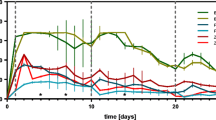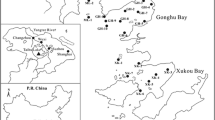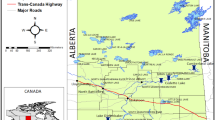Abstract
Fish-eating waterbirds from the Great Lakes of North America have shown symptoms of poisoning similar to those observed in laboratory exposures of various avian species to planar halogenated hydrocarbons (PHHs). PHHs, include among others, polychlorinated biphenyls (PCBs), polychlorinated dibenzo-p-dioxins (PCDDs), and polychlorinated dibenzofurans (PCDFs) and have been implicated in some of the reproductive problems of Great Lakes waterbirds. The objectives of this study were to assess the overall potencies of PCB-containing extracts from colonial water-bird eggs taken from the Great Lakes and to compare the potencies with the location and spatial distribution of the colonies. The potencies of the extracts were assessed by their ability to induce cytochrome P450IA1-associated ethoxyresorufin O-deethylase (EROD) activity in H4IIE rat hepatoma cells as compared to the standard, 2,3,7,8-tetrachlorodibenzo-p-dioxin (TCDD). The H4IIE bioassay-derived TCDD-equivalents (TCCD-EQs) in the waterbird eggs concur with residue analyses and biological data from other studies. The greatest concentrations of TCDD-EQs were found in waterbird eggs from historically polluted, industrialized or urbanized areas in which the reproductive impairment of colonial waterbirds was most severe. However, significant concentrations of TCDD-EQs were detected at all sites tested; with a range of 49 to 415 pg TCDD-EQ/g egg, uncorrected for extraction efficiencies. The H4IIE bioassay proved to be a useful biomonitoring tool to assess the overall potency of complex PHH mixtures in environmental samples.
Similar content being viewed by others
References
Abbott BD, Birnbaum LS (1989) Cellular alterations and enhanced induction of cleft palate after coadministration of retinoic acid and TCDD. Toxicol Appl Pharmacol 99:287–301
Ax EL, Hansen LG (1975) Effects of purified polychlorinated biphenyl analogs on chicken reproduction. Poult Sci 54:895–900
Bandiera S, Sawyer T, Romkes M, Zmudzka B, Safe L, Mason G, Keys B, Safe S (1984) Polychlorinated dibenzofurans (PCDFs): effects of structure on binding to the 2,3,7,8-TCDD cytosolic receptor protein, AHH induction and toxicity. Toxicol 32:131–144
Bannister R, Davis D, Zacharewski T, Tizard I, Safe S (1987) Aroclor® 1254 as a 2,3,7,8-tetrachiorodibenzo-p-dioxin antagonist: effects on enzyme induction and immunotoxicity. Toxicol 46:29–42
Baumann PC, Whittle DM (1988) The status of selected organics in the Laurentian Great Lakes: an overview of DDT, PCBs, dioxins, furans, and aromatic hydrocarbons. Aquatic Toxicol 11:241–257
Birnbaum LS, Weber H, Harris MW, Lamb JC, McKinney JD (1985) Toxic interaction of specific polychlorinated biphenyls and 2,3,7,8-tetrachlorodibenzo-p-dioxin: Increased incidence of cleft palate in mice. Toxicol Appl Pharmacol 77:292–302
Bradlaw JA, Casterline JL (1979) Induction of enzyme activity in cell culture: A rapid screen for detection of planar polychlorinated organic compounds. J Assoc Offic Anal Chem 62:904–916
Brunstrom B (1986) Activities in chick embryos of 7-ethoxycoumarin O-deethylase and aryl hydrocarbon (benzo[a]pyrene) hydroxylase and their induction by 3,3′,4,4′-tetrachlorobiphenyl in early embryos. Xenobiotica 16:865–872
— (1989) Toxicity of coplanar polychlorinated biphenyls in avian embryos. Chemosphere 19:765–768
— (1990) Mono-ortho-chlorinated chlorobiphenyls: toxicity and induction of 7-ethoxyresorufin O-deethylase (EROD) activity in chick embryos. Arch Toxicol 64:188–192
Brunstrom B, Andersson L (1988) Toxicity and 7-ethoxyresorufin O-deethylase-inducing potency of coplanar polychlorinated biphenyls (PCBs) in chicken embryos. Arch Toxicol 62:263–266
Casterline JL, Bradlaw JA, Puma BJ, Ku Y (1983) Screening of fresh water fish extracts for enzyme-inducing substances by an aryl hydrocarbon hydroxylase induction bioassay technique. J Assoc Offic Anal Chem 66:1136–1139
Cecil HC, Bitman J, Lillie RJ, Fries GF, Verret J (1974) Embryotoxic and teratogenic effects in unhatched fertile eggs from hen fed polychlorinated biphenyls (PCBs). Bull Environ Contam Toxicol 11:489–495
Davis D, Safe S (1988) Immunosuppressive activities of polychlorinated dibenzofuran congeners: quantitative structure-activity relationships and interactive effects. Toxicol Appl Pharmacol 94:141–149
Elder GH (1978) Porphyria caused by hexachlorobenezene and other polyhalogenated aromatic hydrocarbons. In: DeMatteis F, Aldridge WD (eds) Heme and hemoproteins. Springer-Verlag, NY, pp 157–200
Eisenreich SJ, Looney BB, Thorton JD (1981) Airborne organic contaminants in the Great Lakes ecosystem. Environ Sci Technol 15:30–38
Finney DJ (1978) Statistical methods in biological assay. 3rd ed. Charles Griffin and Co, London
Fox GA, Collins B, Hayakawa E, Weseloh DV, Ludwig JP, Kubiak TJ, Erdman TC (1991) Reproductive outcomes in colonial fisheating birds: a biomarker for developmental toxins in Great Lakes food chains II. Spatial variation in the occurrence and prevalence of bill defects in young double-crested cormorants in the Great Lakes, 1979–1987. J Great Lakes Res (in press)
Fox GA, Kennedy SW, Norstrom RJ (1988) Porphyria in herring gulls: A biochemical response to chemical contamination of Great Lakes food chains. Environ Toxicol Chem 7:831–839
Fox GA, Weseloh DV (1987) Colonial waterbirds as bioindicators of environmental contamination in the Great Lakes. In: Diamond AW, Filion FL (eds) The value of birds. ICBP Tech Publ 6, Cambridge UK, pp 209–216
Gilbertson M (1983) Etiology of chick edema disease in herring gulls in the Lower Great Lakes. Chemosphere 12:357–370
Gilbertson M, Fox GA (1977) Pollutant-associated embryonic mortality of Great Lakes herring gulls. Environ Pollut 12:211–216
Goldstein JA (1980) Structure-activity relationships for the biochemical effects of relationship to toxicity. In: Kimbrough RD (ed) Topics in environmental health: Vol 4, Halogenated biphenyls, terphenyls naphthalenes, dibenzodioxins and related products. Elsevier North-Holland, NY, pp 151–190
Greenlee WF, Neal RA (1985) The Ah receptor: A biochemical and biologic perspective. In: The receptors, Vol II, pp 89–129
Harris HJ (1988) Persistent toxic substances and birds and mammals in the Great Lakes. In: Evans MS (ed) Toxic contaminants and ecosystem health: A Great Lakes focus. John Wiley and Sons, NY, pp 557–569
Higginbotham GR, Huang A, Firestone D, Verrett J, Ress J, Campbell AD (1968) Chemical and toxicological evaluations of isolated and synthetic chloroderivatives of dibenzo-p-dioxins. Nature 220:702–703
Hoffman DJ, Rattner BA, Sileo L, Docherty D, Kubiak T (1987) Embryotoxicity, teratogenicity, and aryl hydrocarbon hydroxylase activity in Forster's terns in Green Bay, Lake Michigan. Environ Res 42:176–184
Kubiak TJ, Harris HJ, Smith LM, Schwartz T, Stalling DL, Trick JA, Sileo L, Docherty D, Erdman TC (1989). Microcontaminants and reproductive impairment of the Forster's tern in Green Bay, Lake Michigan-1983. Arch Environ Contam Toxicol 18:706–727
Kurita H, Ludwig JP, Ludwig ME (1987) Results of the 1987 Michigan colonial waterbird monitoring project on Caspian terns and double-crested cormorants: Egg incubation and field studies of colony productivity, embryologie mortality and deformities. Ecological Research Services. Report to Mich Dept Nat Res
Leece B, Denomme MA, Towner R, Li SMA, Safe S (1985) Polychlorinated biphenyls: correlation betweenin vivo andin vitro quantitative structure-activity relations (QSAR). J Toxicol Environ Health 16:379–388
Lowry OH, Rosebrough NJ, Farr AL, Randall RJ (1951) Protein measurement with Folin phenol reagent. J Biol Chem 193:265–275
Mason G, Sawyer T, Keys B, Bandiera S, Romkes M, Piskorska-Pliszczynska J, Zmudzka B, Safe S (1985) Polychlorinated dibenzofurans (PCDFs): Correlation betweenin vivo andin vitro structure-activity relationships. Toxicol 37:1–12
Niimi AJ, Oliver BG (1989) Assessment of relative toxicity of chlorinated dibenzo-p-dioxins, dibenzofurans, and biphenyls in Lake Ontario salmonids to mammalian systems using toxic eqivalency factors (TEF). Chemosphere 18:1413–1423
Niwa A, Kumaki K, Nebert DW (1975) Induction of aryl hydrocarbon hydroxylase activity in various cell cultures by 2,3,7,8-tetrachlorodibenzo-p-dioxin. Mol Pharmacol 11:399–408
Peakall DB (1988) Known effects of pollutants on fish-eating birds in the Great Lakes of North America. In: Proceedings of the World Conference on Large Lakes. May 18–21, 1986, Mackinac Island, MI. Vol 1. Chronic effects of toxic contaminants in large lakes. Chap 4
Pohl RJ, Fouts Jr (1980) A rapid method for assaying the metabolism of 7-ethoxyresorufin by microsomal subcellular fractions. Analyt Biochem 107:150–158
Poland A, Glover E (1973) Studies on the mechanism of toxicity of the chlorinated dibenzo-p-dioxins. Environ Health Perspec 5:245–251
Poland A, Knutson JC (1982) 2,3,7,8-tetrachlorodibenzo-p-dioxin and related halogenated aromatic hydrocarbons: examination of the mechanism of toxicity. Ann Rev Pharmacol Toxicol 22:517–554
Safe S (1986) Comparative toxicology and mechanism of action of polychlorinated dibenzo-p-dioxins and dibenzofurans. Ann Rev Pharmacol Toxicol 26:371–399
— (1987) Determination of 2,3,7,8-TCDD toxic equivalent factors (TEFs): Support for the use of thein vitro AHH induction assay. Chemosphere 16:791–802
Safe S, Phil D (1990) Polychlorinated biphenyls (PCBs), dibenzop-dioxins (PCDDs), dibenzofurans (PCDFs), and related compounds: Environmental and mechanistic considerations which support the development of toxic equivalency factors (TEFs). Crit Rev Toxicol 21:51–88
SAS Institute Inc. (1982) SAS users guide: Statistics. Box 8000, Cary, NC
- (1987) SAS/STAT guide for personal computers, version 6 edition. Box 8000, Cary NC
Sawyer T, Safe S (1982) PCB isomers and congeners: Induction of aryl hydrocarbon hydroxylase and ethoxyresorufin O-deethylase enzyme activites in rat hepatoma cells. Toxicol Lett 13:87–94
Sawyer TW, Vatcher AD, Safe S (1984) Comparative aryl hydrocarbon hydroxylase induction activities of commercial PCBs in Wistar rats and rat hepatoma H-4-II-E cells in culture. Chemosphere 13:695–701
Sawyer TW, Safe S (1985)In vitro AHH induction by polychlorinated biphenyl and dibenzofuran mixtures: Additive effects. Chemosphere 14:79–84
Spear PA, Bourbonnais DH, Peakall DB, Moon TW (1989) Dove reproduction and retinoid (vitamin A) dynamics in adult females and their eggs following exposure to 3,3′, 4,4′-tetrachlorobiphenyl. Can J Zool 67:908–911
Spear PA, Bourbonnais DH, Norstrom RJ, Moon TW (1990) Yolk retinoids (vitamin A) in eggs of the herring gull and correlations with polychlorinated dibenzo-p-dioxins and dibenzofurans. Environ Toxicol Chem 9:1053–1061
Tanabe S, Kannan N, Subramanian A, Watanabe S, Tatsukawa R (1987) Highly toxic coplanar PCBs: Occurrence source, persistency and toxic implications to wildlife and humans. Environ Pollut 47:147–163
Thunberg G (1984) Effects of TCDD on vitamin A and its relation to TCDD-toxicity. In: Poland A, Kimbrough R (eds) Bradbury Report 18: Biological mechanisms of dioxin action. Cold Spring Harbor Laboratory, Cold Spring Harbor, NY, pp 333–344
Tillitt DE, Ankley GT, Giesy JP (1989) Planar chlorinated hydrocarbons (PCHs) in colonial fish-eating waterbird eggs from the Great Lakes. Mar Environ Res 28:505–508
Tillitt DE, Giesy JP, Ankley GT (1991) Characterization of the H4IIE rat hepatoma cell bioassay as a tool for assessing toxic potency of planar halogenated hydrocarbons (PHHs) in environmental samples. Environ Sci Technol 25:87–92
Trotter WJ, Young SJV, Casterline JL, Bradlaw JA, Kamps LR (1982) Induction of aryl hydrocarbon hydroxylase activity in cell cultures by Aroclors®, residues from Yusho Oil samples, and polychlorinated biphenyl residues from fish samples. J Assoc Offic Anal Chem 65:838–841
Tumasonis CF, Bush B, Baker FD (1973) PCB levels in egg yolks associated with embryonic mortality and deformity of hatched chicks. Arch Environ Contam Toxicol 1:312–324
U.S. Food and Drug Administration (1979) Pesticide analytical manual, Vol I. Washington, DC, Sec. 212.13a
Weber H, Harris MW, Haseman JK, Birnbaum LS (1985) Teratogenic potency of TCDD, TCDF and TCDD-TCDF combinations in C57BL/6N mice. Toxicol Lett 26:159–167
Whitlock JP (1987) The regulation of gene expression by 2,3,7,8-tetrachlorodibenzo-p-dioxin. Pharmacol Rev. 39:147–161
Zar JH (1974) Biostatistical analysis. Prentice Hall Inc, Engiewood Cliffs, NJ
Author information
Authors and Affiliations
Rights and permissions
About this article
Cite this article
Tillitt, D.E., Ankley, G.T., Verbrugge, D.A. et al. H4IIE rat hepatoma cell bioassay-derived 2,3,7,8-tetrachlorodibenzo-p-dioxin equivalents in colonial fish-eating waterbird eggs from the Great Lakes. Arch. Environ. Contam. Toxicol. 21, 91–101 (1991). https://doi.org/10.1007/BF01055562
Received:
Revised:
Issue Date:
DOI: https://doi.org/10.1007/BF01055562




